After 5 months of nearly 100% month over month traffic growth, we had our first down month in April.
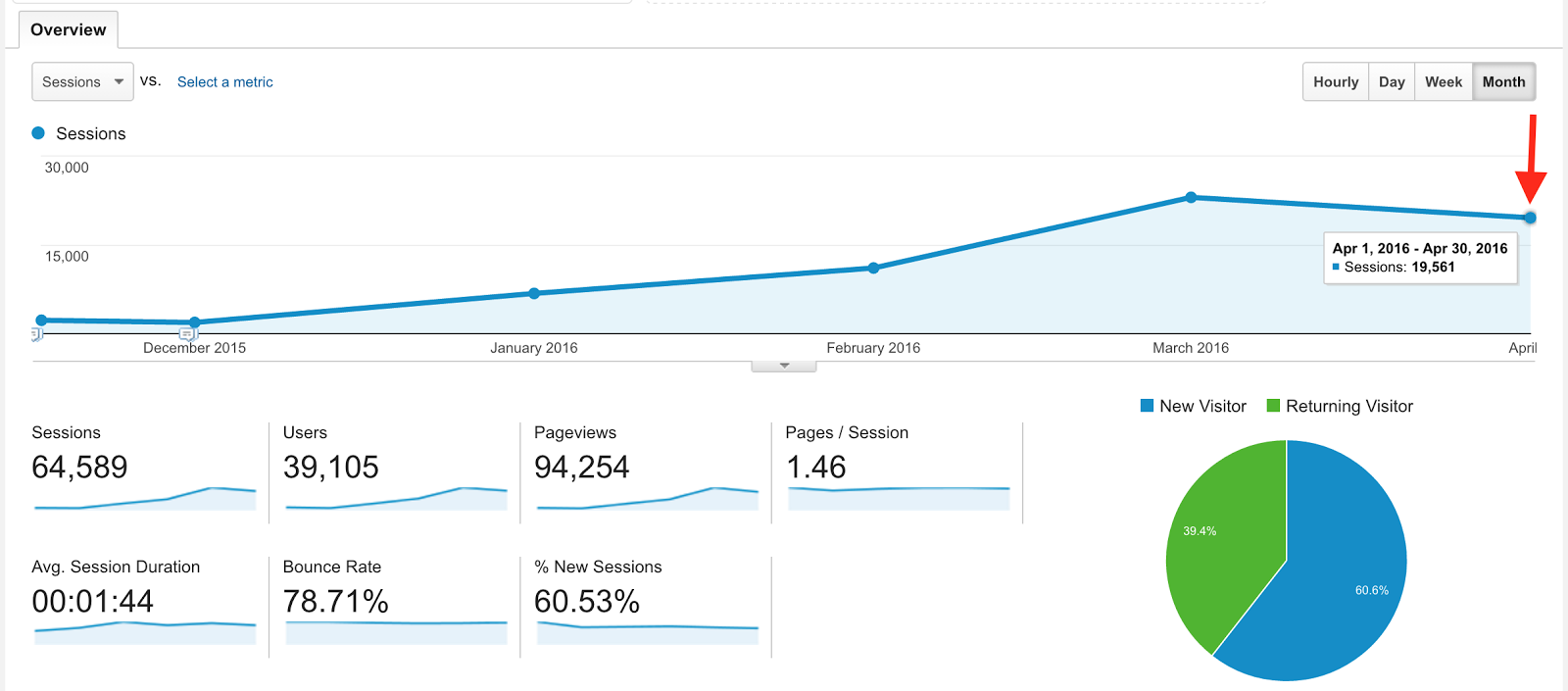
For those that haven’t been following Grow and Convert over the last 6 months, Devesh and I embarked on a journey to grow this site from a brand new domain to 40,000 unique monthly visitors in a 6 month time frame.
There were four main reasons behind doing this:
- I wanted to beat my previous achievement of growing the ThinkApps blog from 0-35,000 unique monthly visitors in 6 months.
- We thought that it was important to build a loyal following and to build trust with our audience before we ever built the business side of Grow and Convert. We thought if we just focused on helping people as the number one goal in our business, that the trust and credibility would be there when we started building products.
- We wanted to prove that we knew what we were talking about when it came to content marketing. Instead of just talking theory, we wanted to share case studies and things that we’ve actually done because we thought that was the most effective way to teach people. We also wanted to be fully transparent in everything that we did because we saw that being real is rare these days.
- We thought that if we documented our journey growing our site using the same tactics we share with others, then people can follow along, see exactly what we’re doing, and it proves that if you follow a process, that you can grow quickly and acquire customers for your company at a low CAC (customer acquisition cost).
But about halfway through March we decided to forfeit our 40,000 unique monthly visitors in 6 months goal for the sake of the business.
While it is a hard decision to publicly admit that we aren’t going to hit this goal, we did it because keeping Grow and Convert alive was more important than hitting an artificial traffic goal.
We felt like we had achieved the two most important reasons for setting this goal, which was to:
1. Build a following and trust with our audience
2. Prove that we knew what we were talking about when it comes to content marketing
I was willing to swallow my pride and sacrifice beating my own goal so that we could both continue to work on Grow and Convert.
The fact of the matter is that I quit my full-time job to go all in on this. I’m currently living abroad off of my savings while trying to bootstrap this business.
Devesh has a thriving agency that’s doing better than ever before.
For both of us to continue to spend time working on this, we had to start monetizing Grow and Convert.
So we decided to switch our goal.
Before we get into what our new goal is, and how that impacts our site going forward, let’s recap what happened in April.
April – Our First Down Month, Why We Fell Short of Our Goal
I’m going to turn it over to Devesh to update us on April’s traffic stats…
Traffic: 14% Decrease from March
We only got 12,791 users in April, a 14% decrease from the 14,800 users in March.
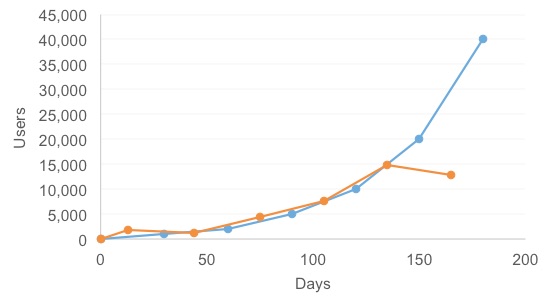
As the kids say these days, “NBD” (or “no big deal” for those of you that don’t understand the kids these days).
Ever since we took care of these two big things up front, there have been few surprises:
- Built a growth model, so we know (roughly) what traffic will be like even before the month is over.
- Focus on one goal at a time, which for us now is not traffic, so we’re fine with that plot above.
Nonetheless let’s dive into the traffic details.
Number of posts published in April: Three
I’ll give you one guess what the #1 deciding factor of our traffic on any given month is…
(If you’re not sure, you can read this post introducing our straightforward traffic growth model, and this post recapping how we did versus the model in March.)
It’s the number of posts. This is because this site and domain are 6 months old and (although we’ve been pleasantly surprised at how many links we’ve built “naturally”) SEO traffic is still a relatively small percentage.
We only wrote 3 posts in April. This is contrast to 7 posts in March.
Interesting Metric to Think About: Users per New Posts
An interesting, albeit non-scientific comparison is the ratio of traffic in a month (users) per new posts published that month. It gives you a general sense of how much traffic your existing content is pulling in without you having to crank out more and more posts.
For example, a site with a lot of existing links pointing to it and thus healthy SEO and referral traffic can get away with not posting a lot (or at all) in any given month and traffic should remain relatively steady.
Not true for a new content marketing operation like ours.
Here’s our users per new posts rate for the life of Grow and Convert:
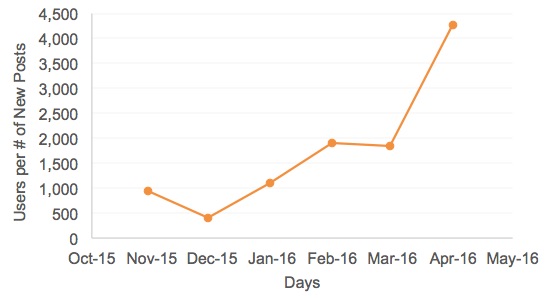
Interesting.
When you look at it like this, April was our best month yet, by a lot. Why is this?
April’s traffic decreased 14%, but we published 62.5% fewer posts, so our users/post metric is actually really high.
How is it that we got so much more traffic per post in April?
It really comes down to two options: (1) Did the posts in April just get crazy traffic (i.e. go viral)? Or (2) do we just have a solid amount of traffic coming in to our existing content.
We can simply look at the top 10 posts in April to verify.
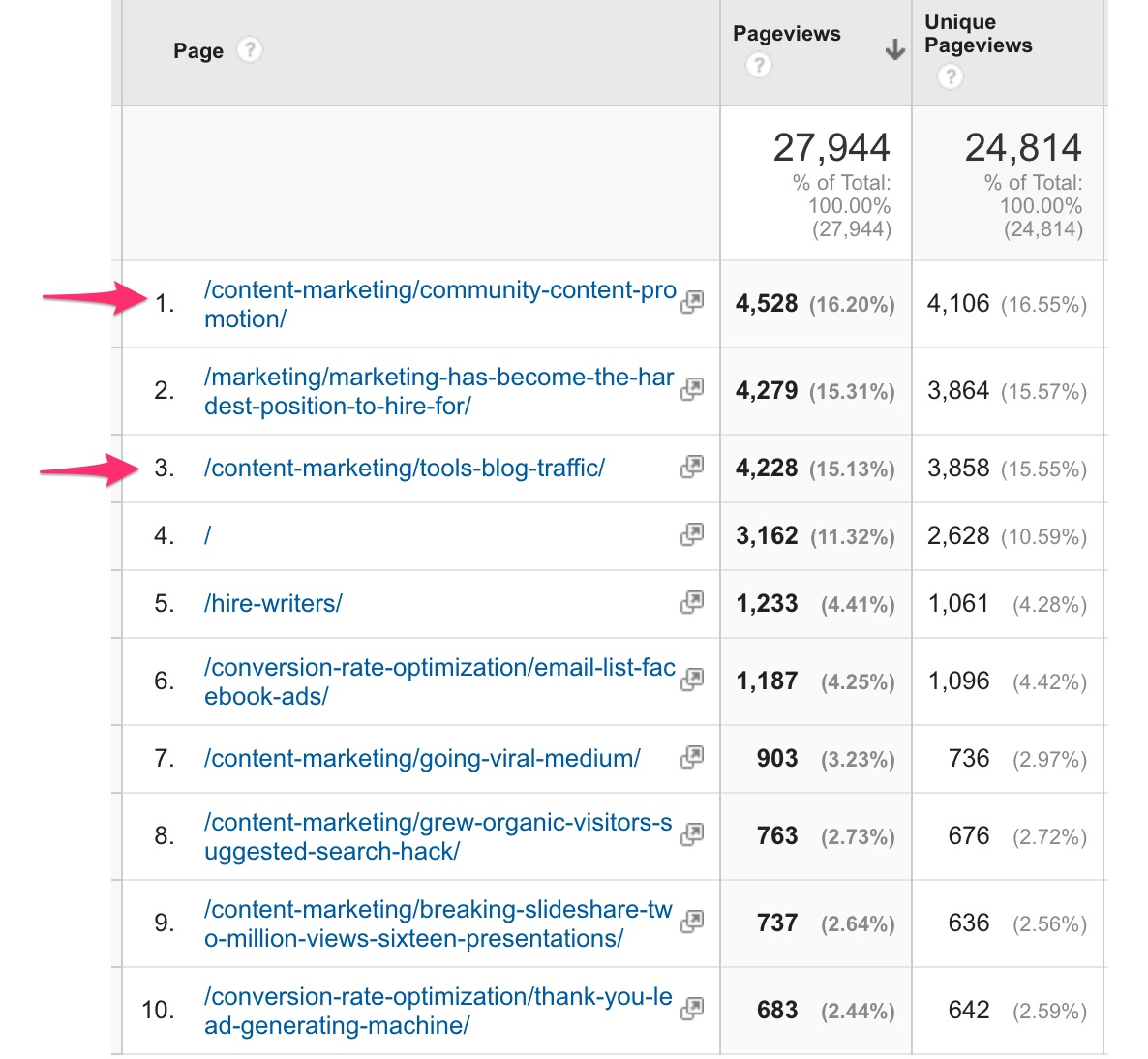
It looks like the 3 April posts (2 of them are pointed to above) made up about 34% of April traffic. That means existing content comprised 66% of our traffic in April.
Is that good? Who knows.
Deciding whether this is “good” is not about comparing to some “industry standard”, it’s just about comparing to where you were last month. And clearly from the users/new posts published graph, we are doing better and better. That is, we are increasingly less reliant on new posts to drive traffic.
Now let’s look at where the traffic is coming from and see what we can uncover…
Acquisition: Still mostly communities, SEO slowly rising.
Here’s where April traffic came from:
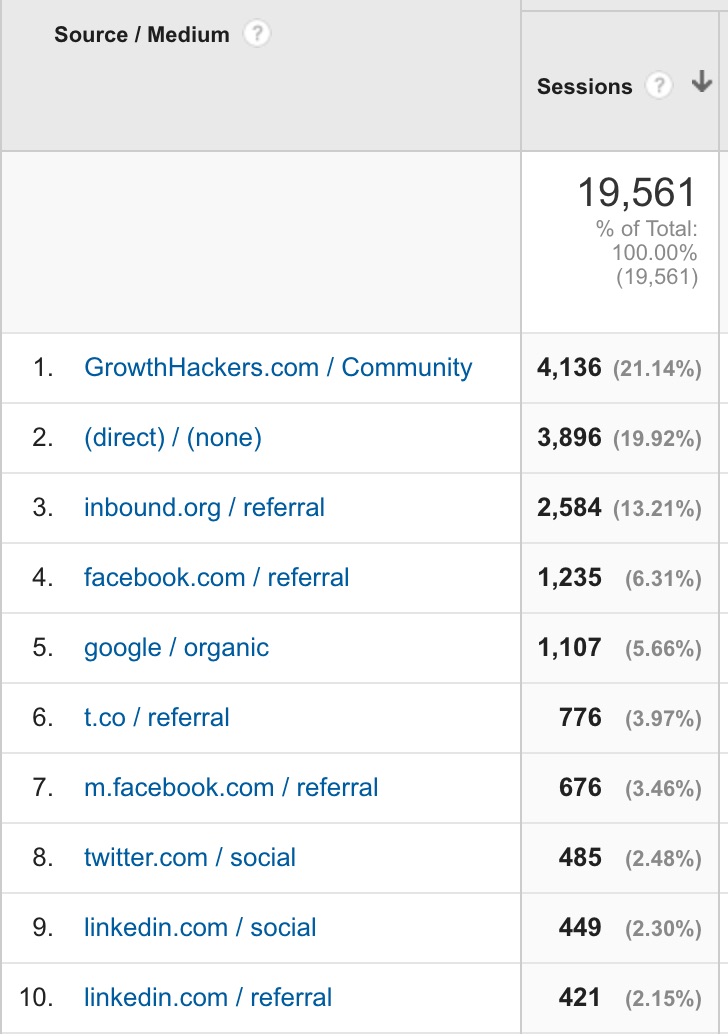
Communities still dominated for us in April.
The most interesting (and exciting) stat, though is that SEO traffic crossed 1000 sessions for the first time. Getting a steady stream of SEO traffic is one of the biggest successes in content marketing. Once that happens, the traffic continues to roll in, even if publication rates slow down.
Here’s how our SEO sessions have been trending since we bought this domain 6 months ago.

That graph is not exponential, and April showed a decrease in slope for the first time, but it’s steady month over month growth in SEO traffic.
It’s also interesting to observe “leading indicators” of SEO like impressions, CTR, and average position. Average position is particularly interesting since cracking the first page on a few keywords is often the key to steady SEO traffic.
Here’s how are average position has changed over the last 90 days:

In intentionally hovered my mouse over a date in May so you could see we’re now bouncing around 15, which means the second page…on average.
What’s interesting is that comparing this to other blogs that have substantial SEO traffic, I’ve noticed that even the most “SEO-ed” blogs don’t have an average position below the teens.
So it seems it may be a game of getting a few key keywords to crank up to the first page to start driving more SEO traffic.
Also our MOZ domain rank is now 33. Shortly after we started, it was at 22, so this is also a great sign.
Email List
This is the convert of Grow and Convert, which is my responsibility, and to be honest it’s not stellar. Like I mentioned in our last update, for the type of content (and quantity) that we publish, it’s largely a function of content upgrades. If we have a content upgrade on our article at the time of publishing, we grow our list, if we don’t, it’s not good.
Here’s where we are relative to our curve:
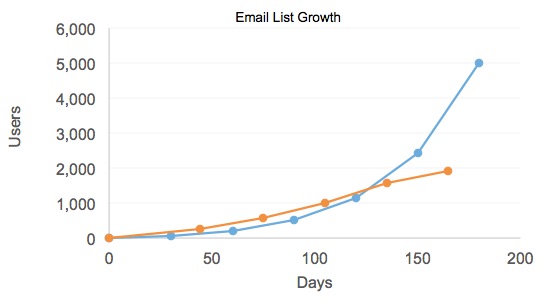
As usual we have posts that got a ton of traffic that we didn’t make content upgrades, nor did we PDF the posts and offer those.
Considering the post we linked to above talks about the problem of time in making content upgrades and how we could just PDF the post to solve this problem, this is simply inexcusable.
It will need to be fixed going forward.
In addition our homepage could be made into a proper homepage gate, which should increase conversion rate there. These are all priorities which are getting pushed off due to product development.
Which leads me to handing it back to Benji…
What is our new goal?
We’ve stated the importance of having one singular goal many times.
Having one singular goal has made it really easy for Devesh and me to stay on the same page about business decisions and keep us focused and motivated on one outcome. For example, since traffic has been our one goal for the past 6 months, we’ve slipped on list building as Devesh mentioned above.
Now, since our overarching goal is to turn Grow and Convert from a site into a business, we revised the previous goal that Devesh had outlined in our March recap “SEO and List building,” to one that more aligns with our new focus.
Our new goal is 30 paying customers across all of our revenue generating activities. This includes Wordable, coaching, and our new training program (which we’ll share below).
Why 30 paying customers and not a goal tied to revenue?
At the early stage of building a company, we’re not solely focused on revenue. We’re focused more on the validation of our idea and ensuring we have product/market fit with whatever we build.
Revenue targets will become more important once we’ve validated that we’ve built the proper products for the proper audience and that the products have the potential to scale.
Because we haven’t validated our ideas or pricing yet, our product offerings may change.
Companies pivot all the time (as you have just seen).
So, we don’t believe in having monetary goals at this point.
The #1 goal for us to validate is that we’ve built enough trust to get 30 people within companies to pay us, either for our training or for our software.
Content Marketing Training? Introducing Customers From Content
Where we feel like we have the upper hand against other marketing sites is that we’re focused on getting customers for existing businesses using content marketing. Not using a blog to build a personal brand, or “break the 9 to 5”, or “start a side business” for individuals, but using content as a customer acquisition channel for existing businesses that have to compete side by side with all other acquisition channels (like paid media).
And the best part? We have real experience doing so. I’ve grown content-based traffic (often from next to nothing) for Vistage, ThinkApps, and Everwise, and Devesh has converted traffic to content for companies like ValueWalk, When I Work, and Backlinko.
When brainstorming how we could further help businesses with content marketing beyond just writing in-depth case studies, we kept coming back to a differentiating factor in what we’re doing: systems.
Our strategies aren’t just a buffet table of “throw spaghetti against a wall and see what sticks”. It’s instead a system:
- A system for aligning content with customers along their journey
- A system for filtering the multitude of promotion tactics into a select few to focus resources on
- A system for modeling growth and making it predictable
- A system for distilling the conversion tactics into a select few that work best
We want to teach this system to companies looking to grow digital lead generation through content or start lead generation through content.
That’s what Customers from Content is: our system.
It walks through detailed strategy around the four areas we feel define our system:
1. Content Strategy – How to produce the right content
2. Content Promotion – How to promote that content efficiently
3. Content Conversion – How to convert blog traffic to customers
4. Measurement and ROI – How to model and measure your acquisition rate and cost so lead generation from content marketing becomes precise.
But before we release this system to a wider audience, we want to validate it with 10 early adopters, whom we will personally walk through our system via recorded video calls over the course of 8 weeks.
Since this is hands on, we can only accept a limited number of companies for this program. We’ve set this number to 10.
Update: We are currently full!
What Does These Changes Mean For Our Monthly Updates?
Don’t worry – We’re going to continue to deliver our monthly updates which we know many of you have grown to love.
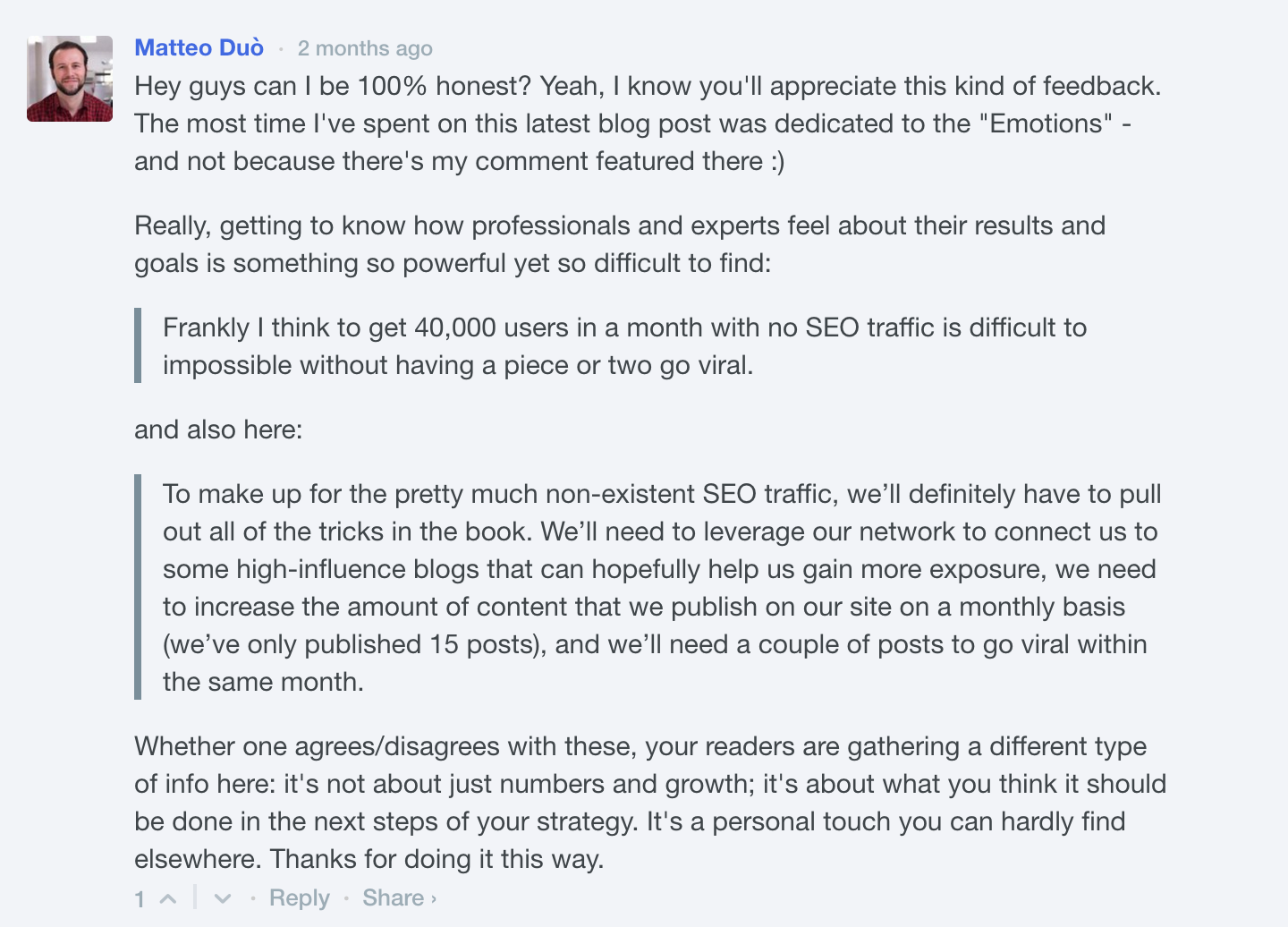

But they will be changing a little bit.
Instead of providing just traffic and list growth information, we’ll be providing information about the metrics we think our most pertinent to our business.
That way, you’ll be able to see how we think about how content marketing ties into our business objectives.
But this brings up an important point…
How Transparent Are We Going To Be Going Forward with Customer and Revenue Information?
While transparency is a core value of our business, we do have to draw the line somewhere on the information we share publicly.
We don’t think it will help our audience to share revenue information from selling courses because our audience doesn’t sell courses. If we were a site that targeted solopreneurs then this type of content may be interesting to them. But we’re not. There are plenty of other sites that do that.
We do think it makes sense to share revenue & customer information on Wordable, because Wordable is a SaaS business and more closely reflects a business that our target audience would be looking to grow.
Therefore it makes for interesting lessons to see how we’re able to grow Wordable with content marketing.
Division of Labor – Splitting Our Roles
As a business starts to grow and take shape, it’s important for us to leverage each of our strengths to scale this business to it’s fullest potential.
Going forward, I’ll be responsible for everything related to our site growth. This means I’ll be writing a majority of the blog posts going forward so Devesh can focus on other aspects of the business. I’ll also be handling our content promotion, social media, responding to our welcome e-mails and sending out emails to our list.
Devesh will be responsible for everything related to conversion and revenue generation. This means he’ll be focused on increasing our email subscribers by implementing more content upgrades and testing new conversion methods that we can implement. He’ll also be focused on validating our course, building sales pages and communicating with our paying customers.
Since we have a lot on our plate right now, I’m also going to be looking for some outside contributors to start sharing helpful advice with our audience. However, we will not be sacrificing content quality.
As always, we’re looking for actionable case studies from practicing marketers. If you think you’re up for the task, check out our blogger guidelines.
Need an example of the high quality content we’re looking for? Check out our past guest posts:
Breaking SlideShare: How I Got 2,000,000 Views from Only 16 Presentations – by Eugene Cheng
The 3-Step Bulletproof Formula To Writing Kickass Blog Post Headlines – by Danavir Sarria
How to Turn Your Blog’s Thank You Page Into a Lead Generating Machine – by Emil Shour
Where are we relative to our new goal?
So now you’re probably wondering…
“Where are we relative to our new goal?”
As of writing this post we have 7 paying customers. We’re 23% of the way to our goal.
We now have 3 paying customers from Wordable – two on the standard plan and one on the starter plan. And 107 trial customers.
Out of the 9 people that have finished their trial, three people have converted to paying customers – 33% conversion from trial to paying customer… Not bad!
At this point, we haven’t focused on scaling Wordable yet (all of the trials and paying customers so far, came from our one post about Wordable). Nonetheless, over the last 3 weeks we’ve focused heavily on getting user feedback and we’ve uncovered two really valuable lessons:
- People either love Wordable
- They’ve had a bug that prevented them from using it
So over the last few weeks we’ve been working on making bug fixes and feature improvements to ensure we have a solid product before we try to scale it.
I’ve filled two of the five coaching slots for my coaching program in the last week since launching, and Devesh has sold 1 seats for the training program.
Emotions
We realized we skipped this part in our last monthly roundup but we’re bringing it back because it’s really important that we share how we feel throughout this whole process. Starting a business from two sides of the world, while doing other things, isn’t easy and we’ve definitely had our ups and downs.
Benji:
This past month has been a rollercoaster of emotions for me. But first, to answer the question that many people have been asking me:
“Is it hard to stay productive while traveling?”
Yes, It’s been extremely difficult. The first two months of doing this “digital nomad” thing were easy for me because I stayed in one location for a majority of the time. But since April 8th, I’ve been in a new location pretty much every few days and the combination of adjusting to a new place, exhaustion from travel, and trying to keep up on work, is draining.
Therefore I’m switching up my travel strategy. Instead of trying to see new things while growing the business, I’ve decided that it’s best for the business if I stay in one place for the rest of my trip. I’ve realized I’m more focused, have a better routine and get more done when I’m in one place.
That’s why today I bought a ticket back to Bali and will stay there for the remainder of my trip.
Back to the rollercoaster of emotions part…
When I got to Vietnam in late April, I had a mini panic attack. For some reason, I woke up one day and started to doubt myself.
I was almost 6 months into this business and in my mind I had nothing to show for it. We’ve had people saying how much they loved what we were doing, we’ve been able to grow traffic nearly 100% MoM, but I started questioning if we could turn Grow and Convert into a real business.
And it was paralyzing.
Every time I sat down to write nothing would come to my mind.
Every time I tried to promote a piece of content I couldn’t come up with any ideas to do so.
I felt like all of my strengths were suddenly gone and I thought the business was just going to spiral downward until it failed.
I kept thinking:
“What happens if no one wants to buy our services”
“What happens if I have to go back to the states with no money”
“What happens if I have to go back and get another job”
I gave a call to Devesh and told him the problem I was having. I said I was sorry I haven’t been able to do anything lately but I’ve just been in this weird funk and haven’t been able to shake it. To make matters worse, Devesh was going through some serious family health issues of his own, so I didn’t want to push my problems onto him.
But the next day after telling him, we closed our first Wordable customer and Devesh and I talked for two hours and came up with a plan of action for revenue.
Then I mustered up enough self confidence to rewrite the Airbnb post that I had attempted to write 4 times. And after I put that out there, things started falling into place.
Devesh helped me launch my coaching program, we worked on the outline for the course and started to validate it, and more customers started purchasing Wordable on their own.
All signs started pointing to this working after all.
The learning for me was that it’s so important to have a partner that compliments your skill sets and that can be your support system. Had I not been able to communicate with Devesh about the challenges I was having, I likely would’ve still been suffering from a lack of self confidence.
The second learning was that almost everyone goes through the self doubt portion at some point in their business. To overcome it, focus on getting small wins to build back your self confidence and talk to other people who’ve been there before. I found this startup curve from Paul Graham to be helpful.
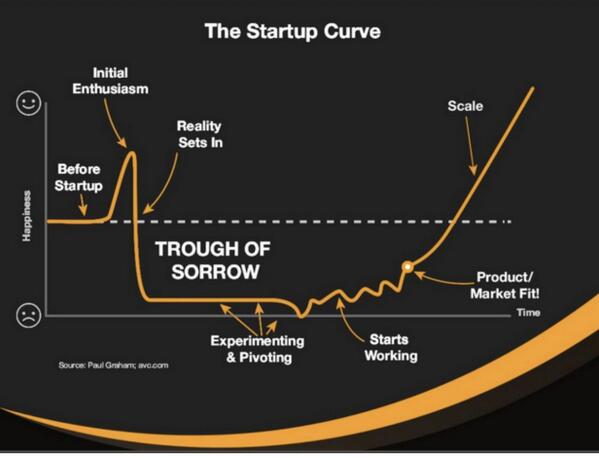
About a month ago reality set in and I was in the trough of sorrow, however after experimenting and pivoting we found that things started working they way we had originally predicted. That built back my self confidence and now I’m more excited than ever to put all of my effort into this business.
Devesh:
Honestly, I feel great about Grow and Convert right now: we continue to get great emails from people, initial validation of our content marketing system via coaching and the training program has been great, and SEO metrics and backlinks are looking up.
What’s there to be sad about?
Two other outside factors have contributed as well. First, my CRO agency is doing well, and I’ve found that when one project or business is doing well that eases pressure off of others. Second, as Benji mentioned, I’ve had some traumatic family issues happen suddenly in April, so that frankly puts things like traffic, business, money, and life in perspective. Business having ups and downs? Not to worry, if I can spend time with people I love, I’m happy.
Want us to write an in depth case study or story about you or your company? We’ll also drive traffic to it. Apply here.
Like this article? We produce stories like these for our clients, learn more here.








